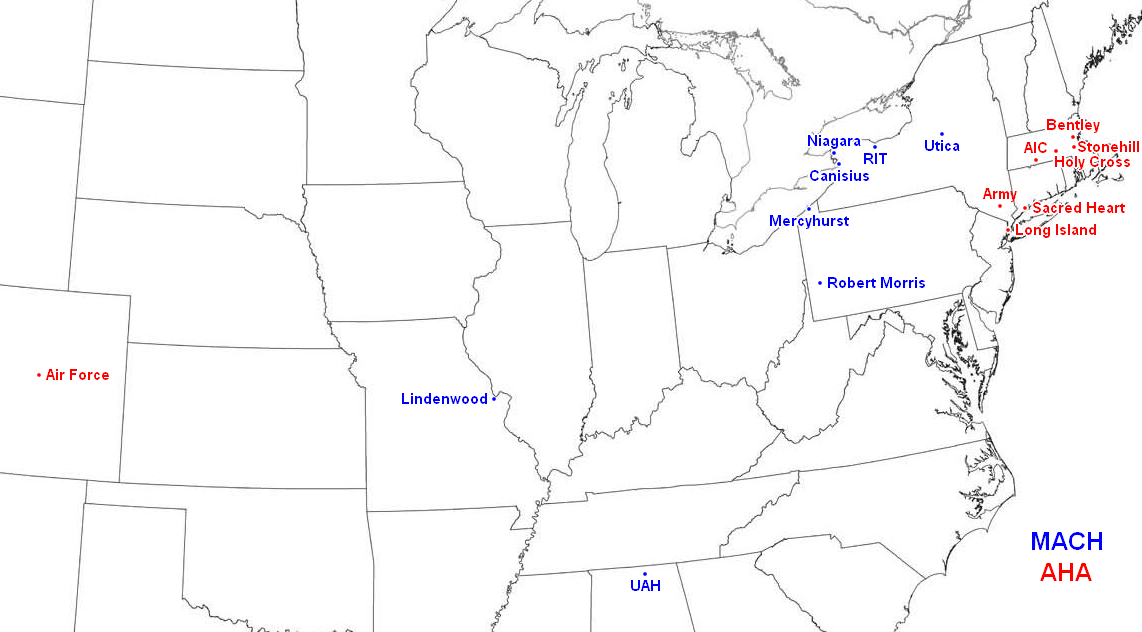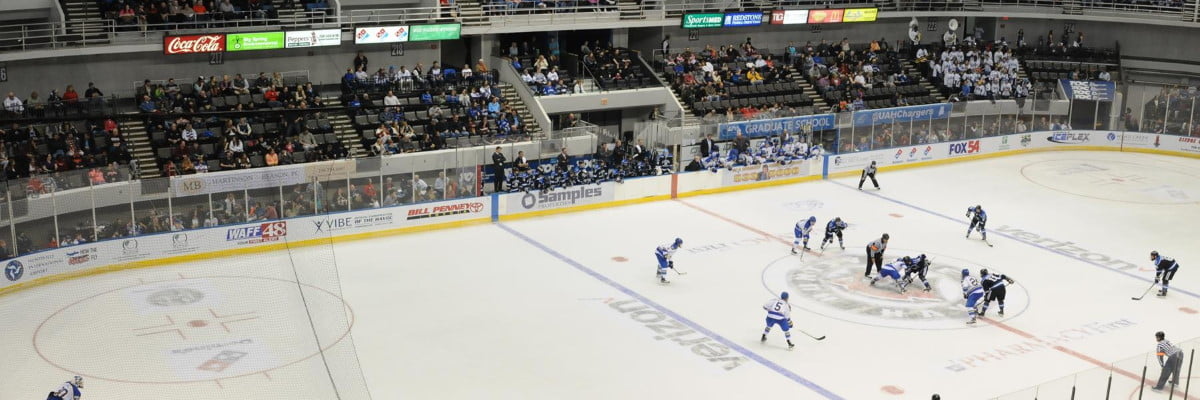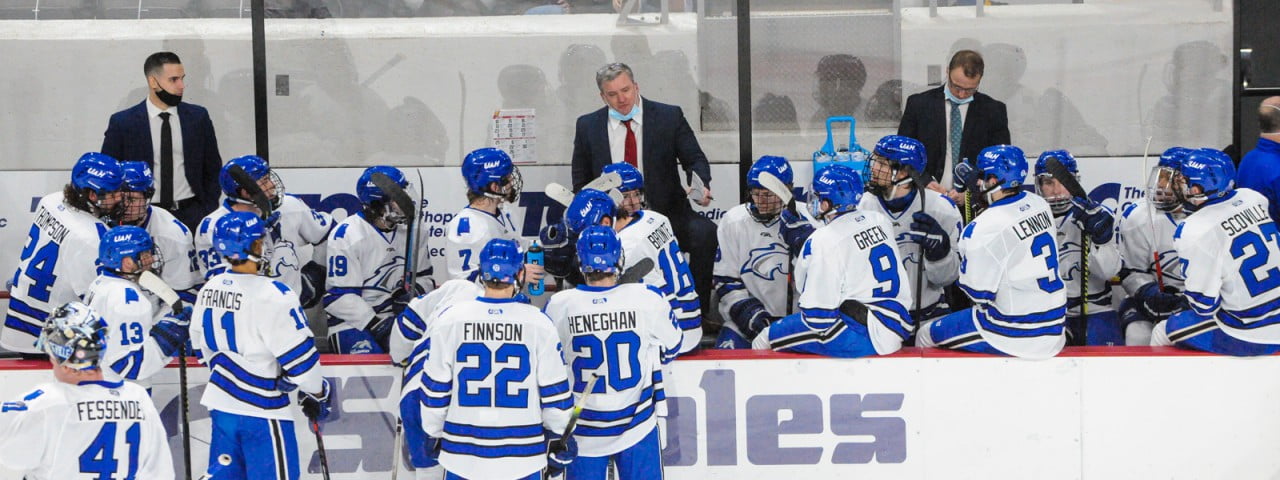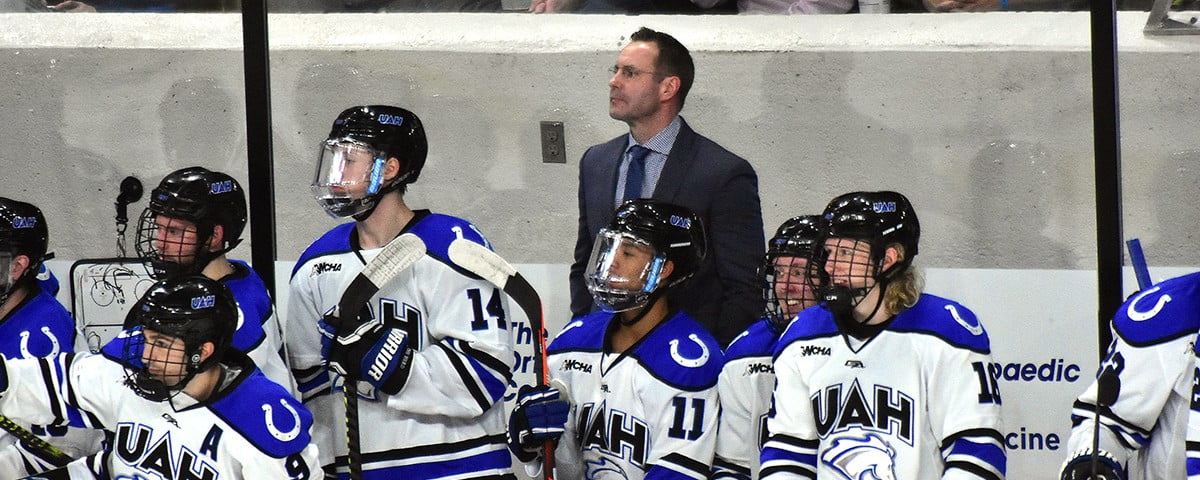Last week, I suggested that Atlantic Hockey split into two conferences to provide homes to the new and independent programs in Division I and to get UAH back into the game.
I’m not the first to pose an idea like this. It was just the latest proposal accounting for the recent developments of new Division I programs at Lindenwood and Stonehill and the expected addition of Utica.
Ed Trefzger, a writer and podcaster for USCHO and the voice of RIT, asked why whenever new programs show up that people expect Atlantic Hockey to accommodate them.
It probably isn’t fair for the burden to fall on Atlantic Hockey, but the problem involves a number of these programs being in the east and how college hockey has elected to structure itself over the past decade.
First, let’s clarify that Atlantic Hockey isn’t the only conference expected to do anything to help the independent programs. With Augustana and Lindenwood in the West, the CCHA is being looked at as the likely conference to bring one or both on — not the NCHC or Big Ten.
It’s the same situation in the East, where Long Island, Stonehill, and Utica will need conferences. No one is looking at any of these schools and immediately saying “that’s a Hockey East school” or “that’s an ECAC school.”
Power conferences want power schools, and until more power schools join Division I hockey, the power conferences won’t do anything, and they won’t be expected to.
Let’s see what the six current conferences could do in this round of realignment.
Big Ten
The Big Ten is currently the smallest conference with seven teams (six regular Big Ten members plus Notre Dame as a hockey-only affiliate). Obviously, any new hockey programs in the Big Ten would go here, with Illinois likely being the eighth if and when it decides to start up.
The Big Ten could consider others to be hockey-only members like Notre Dame. Arizona State, which played nothing but road games against Big Ten teams in the 2020-21 season, might fit the bill as it’s the only Power 5 school looking for a conference. ASU is also finally building its new arena.
NCHC
The most powerful conference in the West has been eight teams since it began play in 2013. The NCHC has not announced any plans for expansion, or be any hurry to whatsoever, so the following is just idle theory.
If the NCHC did decide to expand, there are not many schools within or near its footprint that could match the high-end attributes the league would be looking for. With its aforementioned new arena and Power 5 status, Arizona State could be attractive.
Otherwise, the NCHC could look at current CCHA teams. Minnesota State was denied entry in 2016 but could get another look as it has maintained being a national power under coach Mike Hastings. Or perhaps Bowling Green, one of only two full Division I schools in the CCHA that would unite with fellow MAC members Miami and Western Michigan.
CCHA
The CCHA just finished its first season with eight teams, seven from the old WCHA and St. Thomas. Last year, the CCHA seemed content with its size and told UAH it was not interested. Since then, two new Division I programs have emerged relatively nearby: Augustana and Lindenwood.
Augustana would be the most likely addition, as Sioux Falls, S.D. is just over 150 miles away from Minnesota State (Mankato) and is building an arena. The Vikings plan to begin play in 2023.
Lindenwood formally announced it’s men’s hockey program going Division I last month, starting play this fall. Its St. Charles, Mo., location makes it a geographical fit.
There’s also the chance it considers UAH again, but based on recent history, that seems like a longshot.
Hockey East
The East’s most powerful league has 11 members, so it has room for an even 12th. But like the NCHC, it would want a program with particular qualities. The last time the men’s league expanded was 2014 with the addition of UConn from Atlantic Hockey, which put Hockey East at 12 teams until Notre Dame left for the Big Ten in 2017.
Perhaps if a new men’s program from a Power 5 school in the east emerges (like a Syracuse, for example), maybe Hockey East will make a move, but there’s nothing to suggest it will happen anytime soon.
ECAC
The ECAC is Division I hockey’s largest conference by membership with 12 teams, so whether there’s room for growth is a matter of opinion. It last expanded in 2005 with the addition of Quinnipiac from Atlantic Hockey.
The problem here, too, is that even if the ECAC was open to expansion beyond 12, it’s doubtful that it would consider the three new, would-be, and independent programs in the Northeast (Long Island, Stonehill, and Utica).
Could the Ivy League make an official split from the ECAC, which could allow the ECAC room to take programs like a Sacred Heart from Atlantic Hockey, perhaps making Atlantic more flexible in taking the new programs? They could, but it’s unlikely the Ivies would get any benefit from it.
So that leaves…
Atlantic Hockey
Atlantic Hockey is will be back at 11 teams by 2023 with the official reinstatement of Robert Morris. They could take Long Island, which has been trying to get in since they started. They could take Stonehill, which just announced it was moving up to Division I. They could take Lindenwood, who’s women’s team is in College Hockey America, which shares three teams and administration. When it becomes official, they could take Utica, which led Division III in attendance.
They could also take UAH. They could also do nothing. You know what I think they should do.
Anyone else?
I haven’t even mentioned Alaska Anchorage and Alaska Fairbanks. Before the realignment of 2013, Anchorage was in the old WCHA and Fairbanks was in the old CCHA. Now there is no WCHA and the new CCHA was formed in part to get away from Alaska in the first place, so there’s no reason to think any of the current conferences will consider them.
They’re stuck until more programs start up west of the Rockies. Washington? Oregon? Simon Fraser? These plus the Alaskas and Arizona State could put something together. That would be ideal.
In the end, no conference has to do anything regarding new members. The reason many think Atlantic Hockey (and the CCHA) could — and should — do something to help new and independent programs is because we know the others won’t. It’s why UAH identified Atlantic and CCHA to be the only two possibilities in it’s attempts to join a conference.
Is it fair? No, but what else is there? It may not have always been this way, but men’s hockey has elected to structure itself like every major sport in Division I, where resources and pedigree mean just as much if not more than your geographical location. If you haven’t garnered the resources and pedigree, the options of where you can be accepted are limited. The days where a Ferris State can be in the same league as Michigan are gone.
So, Atlantic Hockey and CCHA, what will you do?









